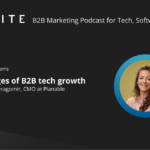How do you get your B2B content reaching the right audience and delivering ROI? This article explains how to get started on creating an SEO optimised content strategy.
A chef can’t throw just any old thing in the pot and hope to create a delicious meal. The same thinking applies to any content marketing strategy. You can’t just sling content on the wall without any plan or idea and see what sticks. If you want to see results, people spending time on your content and high-quality leads, you need to create an SEO optimised content strategy. For some B2B marketers, that’s often easier said than done and plenty of people don’t even know where to start.
There is no universal content strategy that will work for everyone. This will depend a great deal on your topic, target audience, goals and many other things. Fortunately, there are some aspects of digital marketing that are constant and this post aims to help you begin creating an SEO optimised content strategy for your B2B technology business.
Define Your Who
How well do you actually understand your audience? Do you have any idea how and from which channels they’re coming from, what type of content do they actually like to read and their pain points?
Without knowing your audience, creating a content strategy will be one painful search for a needle in a haystack. In the dark. Start by analysing your audience and target customers. What challenges do they face? Where else do they go to consume similar content?
From here, it’s time to research your competition a little. Who visits their website and follows them on social media? Try to understand why they go to your competition and not to you. Perhaps they’re posting more videos than you or perhaps your audience prefers long-form content of your competitor than your short-form blog posts. Maybe their tone of voice is more fun, and it differentiates them in your niche.
Formally defining user personas can have lots of advantages to your marketing, beyond just your content strategy, so is a worthwhile exercise to go through.
What Subjects Should You Cover?
Once you know your who, and particularly their pain points, think about the subject matters that are most important to them. Get your team together and have a brainstorming session – and don’t just get marketing people involved. Sales, business development, product, development and other roles all have their unique understanding of customer pain points, and can probably contribute good ideas here.
If this feels like an overwhelmingly large tasks, a good way of sorting and prioritising all of your content ideas can be to think about which content might work at different stages in the buyer journey.
Buying journeys when selling technology or software products in the B2B space can be very lengthy, and so different content is needed at different points to nurture and guide leads on to the next stage, and ultimately guide their decision making towards your offering.
For example, a prospect that has only just heard about your product as is at the start of the buying journey is likely looking for very different content to a CIO looking for detailed technical information at the final stages of the buying journey.
Think about the format?
Marketers only have a certain number of hours in the day, and with the huge number of different content formats that exist, figuring out which way to go can be hard. Blog posts, infographics, whitepapers, webinars, podcasts, video formats of varying kinds – the list could go on.
Logically, it makes sense to start small on a piece of content and see what works. Invest a small amount of time on a quick content idea on a certain topic, and see if it gains some traction. In most cases, a blog post might be the quickest, easiest and lowest cost form of content to produce.
For example, if you write a SEO optimised blog post that starts to gain some traction from organic search and maybe other channels, then that might be a good indication to invest more heavily in that subject area. At that point you have the business case to prove that there is interest, and so you could look to produce an infographic, short video or another format that needs more time and resource putting into it. By doubling down on this subject area, you can continue to gain traction in reaching new audiences.
YouTube developed a great content model originally for video content but that can work across all content marketing that they call ‘Hero, Hub, Hygiene’. You could also use to help prioritise content themes and formats to add some structure across your content marketing strategy:

Image: Brendan Gahan
Research Keywords Based on Your Subjects
Your brand, product or service doesn’t exist in a vacuum, and it’s quite rare to find a company that doesn’t lean somewhat on the power of organic search. The next step to an SEO optimised content strategy is to do deep strategic keyword research and create a list of as many terms you can think of that are related to your topics.
From here, you can identify their search volume with a little help from Google Keyword Tool. This will give you a good indicator of the level of competition you are facing and what it will take to rank your content high on search engines.
A common mistake trying to rank for the most common keywords. Don’t do that. Unless you have the budget and cash/burn rate of a startup Unicorn you’ll find them too competitive. Instead, use them as a base or support for more niche, long-tail keywords. Make a list of 10-15 broad keywords and then work out long-tail keywords based on them. For example, while it will be too difficult to rank for “Android”, you could narrow this down to “Android Oreo Go” or “Android P Beta”, which will have far less competition and will be far easier to rank for.
Host Your Content On A Company Blog or Resource Hub
There has been lots of debate historically about whether or not to publish content on a company website, or to use an external microsite or platform such as Medium. An advantage is that more people might see your content, however, they may fail to associate it as strongly with your brand and your website itself won’t feel the SEO benefits as strongly.
Having your own little piece of the Internet will allow you to better establish brand authority on your topics and keywords. Produce content for your audience first and what they are interested in and for search engines second. Do it regularly. Once or twice a month might be too inconsistent for modern algorithms so it helps if you’ve implemented your keyword and content research correctly and can deliver content with consistency.
Patience
Ultimately, when creating an SEO optimised technology content strategy there is no quick and easy win. Google has made sure you can’t trick the system. All that’s really left for your company to do is to, implement the plan, be patient and keep an eye on your content strategy success through good use of measurement and reporting tools.
SEO is a marathon, not a sprint and so you won’t see results overnight. Make sure to measure and track the right metrics using what are now indispensable tools like Ahrefs or SEMrush, and they will keep you heading in the right direction.










